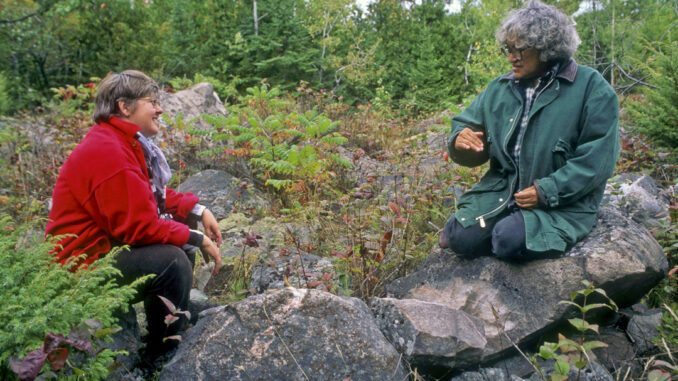
How an American First Nations festival initiated our quest to discover Indigenous cultural experiences in Canada
We were witnessing the mesmerizing dance performances at Red Earth – a Native American cultural festival, held annually in Oklahoma City.
A group of men sat in a circle, pounding a large, round drum with sticks. Elders, parents, teenagers and children resembled a spellbinding kaleidoscope of colour and motion as they danced to the rhythm of the drum.
“We dance because it’s a celebration of life,” explained Lonny, an Indigenous spectator sitting next to us. “When we’re being created, there’s only one thing that we hear – the heartbeats of our mothers,” he said. “Those drumbeats represent the heartbeats of our mothers and of Mother Earth and, as human beings, we find the sound very comforting.”
Hundreds of moccasins pound the floor in time to the drum
Together, we observed the disciplined, graceful movements of the ladies’ traditional buckskin dance; the flowing fringes and ribbons on the dresses of the grass dancers – reminiscent of the windblown prairies; the frenzied movements of the men’s fancy war dance; and the musical clinking of the metallic tube fringes on the jingle dancers’ dresses.
Some dancers imitated eagles. Others wore headdresses topped with one or two feathers mounted in rockers, which moved back and forth with the motion of their heads to the drumbeats.
Youngsters – garbed in feather headdresses and clothing adorned with geometric beadwork – waved feather fans. They learned the dance movements by watching them from their parents’ arms and dancing side by side with the adults.
Dispelling stereotypes
We asked Lonny about the dancers’ apparel. “They are not costumes,” he emphasized. “Our regalia is symbolic. For example, the colours of my ceremonial dress represent the six primary directions, including straight up and straight down.”
“Face painting is another stereotype that Hollywood has plagued us with for generations,” he stated. “It is not war paint. It’s a spiritual protection given to us by our fathers and grandfathers, just as Christians wear crosses,” he claimed. “They paint the design on us the first time, during a ceremony, then we paint ourselves in the same fashion afterwards, for protection.”
Suddenly, the full impact of the festival became apparent to us. Red Earth is about understanding Indigenous Peoples – not so much our differences but, rather, our similarities.
Learning from the Elders
Enlightened by our experiences at Red Earth, we resolved to learn more about Canadian Indigenous culture.
Do you know that there are more than one million First Nations Peoples in Canada who live in 700 unique Indigenous communities, each with its own traditions and history? First Nations Peoples speak more than 50 languages.
Our first encounter was with Mary Okatsiak, an Inuk Elder from Arviat, Nunavut. We, and some other visitors, met her inside a tent that Mary had made from more than two dozen caribou skins.
“A family-sized tent is almost half the size of this tent,” explained Mary, noting that Inuit don’t live in caribou skin tents anymore.
“We stopped living this way in the 1940s and 1950s. I was born in an igloo, but I don’t remember living in one. By the time I was old enough to remember, the Canadian government had built houses for Inuit homes, so we all started living the modern way.”
Mary showed us a knife made from caribou antlers. “Men used these knives to cut snow to make igloos.”
We admired the fine workmanship, noting that the blade was attached to the handle with sinew (dried caribou tendon), which was threaded through holes and tied.
How Inuit lived in the past
As she held up a bundle of sealskin strips, Mary explained that men used to make rope for sleds and dog harnesses by braiding dried strips of sealskin.
She described her caribou skin clothing and explained that if it were a baby-carrying outfit, the hair would be on the inside. Pockets on each end of the shoulders allowed mothers to feed their babies inside the garment when it was cold in the igloo or tent.
“Only a few Elders still wear caribou clothing. Nowadays, Inuit prefer down-filled clothes. For thread, they used to sew with sinew. I use new and improved wax thread,” said Mary, eliciting laughs.
Mary circulated some snow goggles, handmade from a caribou antler. Little slits kept the bright light out of the wearer’s eyes. A strap of caribou skin, with the hair removed, wrapped around the head to hold the goggles in place.
A teenager in our group tried them on. “Young Inuit today prefer UV-protecting sunglasses,” noted Mary.
Someone asked if the snow goggles came in different colours. “No, just basic beige,” she quipped.
One thing that hasn’t changed over the years is that caribou is still the mainstay of Inuit diets. Traditionally, families ate the meat, used the antlers for tools and the pelts for clothing, shelter and mats. But what did they do with the teeth?
Perhaps they created the same thing that Mary made when, years ago, her grandson gave her some caribou teeth. She fashioned them into a necklace with braided sinew and a grizzly bear claw.
Our short time with Mary gave us a much better understanding of Inuit lifestyles, both now and in the past, and motivated us to learn more about Indigenous cultures.
Sharing generations of knowledge
At Serpent River First Nation Reservation between Sudbury and Sault Ste. Marie, Ontario, Isabelle Meawasige and Blain Commanda informed us about Ojibwe traditions. Together, we visited the five-metre-high ceremonial tipi and sweat lodge at their Place of Healing on the tranquil, forested shore of Lake Huron’s North Channel.
“We hold healing weekends here,” said Isabelle. “In order for us to heal Mother Earth of the damage done to her by cutting trees and digging mines, we need to have a cleansing. You use saunas for physical cleansing,” she noted. “We use sweat lodges for physical and spiritual cleansing.”
Blain explained that a sweat lodge is a turtle-shaped frame covered with a carpet, tarps and blankets. “Inside, we fill a pit with hot rocks heated in a spirit fire outside. Other than wood, the only things that go into a spirit fire are tobacco, cedar, sage or sweet grass.”
Isabelle described what happens inside the sweat lodge. “After putting sage and cedar medicine water on the hot rocks, we close the door. We pray to the east, sing a song and then open the door to bring in more hot rocks. Again, we repeat the praying and singing, facing the remaining three directions.”
Isabelle and Blain patiently answered our questions. When the topic shifted to medicinal herbs, they invited us to join them on a walk.
We trailed Blain, as he sure-footedly and swiftly climbed over rocks, ducked under branches and crouched down to examine the ground to show us some golden thread.
Isabelle explained that plants are spiritual beings in Native culture. “If we’re going to harvest a plant, we first offer tobacco in exchange for taking its life.”
Blain poured some tobacco into our palms and instructed us to deposit it into the earth before we picked the small green plant. As we extracted the plant, a long golden root followed. “We sell it by the inch to treat canker sores and stomach problems,” he said.
Isabelle showed us another plant – used as a heart medicine – which grows around the base of spruce trees. Afterwards, she invited us into her home to see her collection of dried herbs, neatly bagged and labelled.
Pointing to some books on herbs, she explained: “We’re still learning by reading, by listening to knowledge-keepers (our Elders) and by sharing information with other Nations during pow wows.”
Isabelle introduced us to her sister, Arnelda Jacobs (who has since sadly passed away). “Basket weaving is a traditional craft,” said Arnelda, showing us some black ash baskets which she had made.
“Legends tell us that the Creator told a chief, in a dream, that his starving people would survive if they made baskets from black ash trees. Following instructions from the dream, they wove baskets and traded them for food.”
As we admired the fine workmanship, Arnelda explained: “I teach the craft to other women – how to find the trees, peel off and pound the layers, cut and dye the strips and weave them into baskets.”
We were touched by the openness and willingness of Arnelda, Isabelle and Blain to share their knowledge.
Wisdom passed down through millennia
When we visited Wanuskewin Heritage Park – 15 minutes north of Saskatoon, Saskatchewan – we learned that the projectile points, pottery shards and other artifacts discovered here date back more than 6,400 years. That makes them older than Egypt’s pyramids!
Wanuskewin – Plains Cree for “seeking peace of mind” – is Canada’s longest-running archaeological site. The National Historic Site includes seven walking trails.
We stepped back in time on an interpretive walk with our Indigenous guide Theresa Hohne, to a medicine wheel believed to be 1,500 years old. Pointing to the central cairn of stones, we asked her if it was used for measuring the seasons or the movement of the sun.
“I don’t know,” she replied, “because nothing was written down; however, oral tradition tells us that it was a sacred site used for ceremonies.”
Nearby, circles of stones marked Wanuskewin’s Sunburn Tipi Ring site. “This was the summer camp because it‘s higher and cooler,” explained Theresa. “The wind kept the mosquitoes away.”
“Because Plains tribes were nomadic, they took everything with them, leaving behind only the stones used to anchor their tents, the bones of the animals they had eaten and the charcoal from their fires.”
Later, in the Visitor Centre, we enjoyed interactive exhibits, art galleries and impressive Indigenous crafts – including beadwork, porcupine quill baskets and jewellery – in the gift shop.
A Cree boy performed a traditional dance in the outdoor amphitheatre, as his father accompanied him with songs, passed down through generations.
Wanuskewin’s restaurant serves Indigenous cuisine, including bison burgers and stew, wild rice salad and freshly made bannock (fried bread).
Wanuskewin serves food for the body as well as the mind.
Elbow River Camp
We learned how to bake bannock at an unlikely place – the Calgary Stampede. Surrounded by a circle of colourful tipis, Treaty 7 First Nations share their cultures with visitors at Elbow River Camp.
Interpreters welcome questions, explain the significance of the tipi designs and demonstrate traditional outdoor cooking and how to make beadwork and jerky. Bannock Booth sells delicious tacos, burgers and breakfast sandwiches made with bannock.
We learned about traditions during storytelling presentations, talked to a chief about his horse as he prepared for the Calgary Stampede parade and listened to dancers describe the meaning of their regalia during daily pow wows. As with other Indigenous encounters, our experiences were enlightening.
How do you find Indigenous cultural experiences across Canada?
The Indigenous Tourism Association of Canada created the Destination Indigenous website to help travellers find Indigenous cuisine, accommodations, museums and experiences. You’ll learn where you can immerse yourself in cultural activities, participate in hands-on arts-and-crafts workshops and join nature tours, ranging from bear watching to guided hikes.
The events section provides information about pow wows, cultural festivals and dance competitions. Delve into Indigenous travel packages by region or category, such as heritage sites and wildlife.
First Nations Peoples in Canada have many stories to tell. If you are like us, you’ll be eager to listen and learn.
By Barb & Ron Kroll
Resources
For more information, visit https://destinationindigenous.ca
Barb & Ron Kroll publish the trip-planning website www.KrollTravel.com
